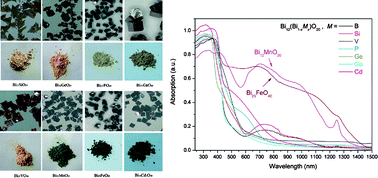Highly crystalline single crystals of sillenite-type Bi10Cd3O20 and Bi12(BixM1−x)O20 (M = B, Si, P, V, Mn, Fe, Ga, Ge) were successfully grown under mild hydrothermal conditions. Bulk crystals with smallest average size of 100 μm and preferable shapes can be obtained by optimizing respective growth conditions. The morphologies for Bi25FeO40 show regular evolutions along with different synthesis routes. Characterizations were performed by means of powder X-ray diffraction analyses, chemical analyses, optical spectra and first-principles calculations. It is found that all of the crystals possess certain transparency along with distinct absorptions in the visible region, corresponding to the discrete MO4 tetrahedra in the crystal lattices. Band gap energies of the fabricated sillenite crystals vary from approximately 1.66 eV for Bi12(Bi0.375Mn0.625)O20 to 2.85 eV for Bi12GeO20, as estimated from the absorption data. The impacts of tetrahedrally coordinated transition-metal cations on their electronic structures were investigated by first-principles computational approaches.

You have access to this article
 Please wait while we load your content...
Something went wrong. Try again?
Please wait while we load your content...
Something went wrong. Try again?


 Please wait while we load your content...
Please wait while we load your content...